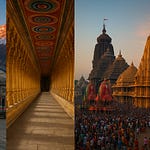The Jagannath Temple in Puri, Odisha, stands as one of the most revered Hindu pilgrimage sites, forming part of the sacred Char Dham circuit alongside Badrinath, Rameswaram, and Dwarka. Dedicated to Jagannath (Lord of the Universe), this iconic temple is not only a symbol of religious devotion but also a testament to India’s rich cultural and architectural heritage. The temple's distinctive rituals, grand festivals, and timeless mysteries continue to attract millions of devotees and travelers from across the globe.
Historical Origins
The Jagannath Temple traces its origins to ancient Indian scriptures and mythology. Although the current temple structure was commissioned in the 12th century CE by King Anantavarman Chodaganga Deva of the Eastern Ganga Dynasty, the worship of Lord Jagannath is believed to predate this period by centuries.
According to legend, King Indradyumna of Malwa was divinely instructed to construct a temple to house the deities Jagannath, Balabhadra, and Subhadra. The Skanda Purana, Brahma Purana, and Mahabharata mention the existence of the temple site, suggesting its spiritual prominence in ancient India. This seamless blend of myth, faith, and history has shaped Puri into one of Hinduism’s most significant religious hubs.
Architectural Marvel
The Jagannath Temple exemplifies Kalinga architecture, characterized by its towering vimana (shikhara), intricate carvings, and large temple complex. The temple stands on an elevated platform, dominating the skyline of Puri.
Key Architectural Features:
Vimana (Main Tower): Soaring over 65 meters, the vimana is crowned with the Nila Chakra (Blue Disc), a symbol of divine protection.
Meghanada Pacheri: The outer boundary wall that encircles the temple complex.
Singhadwara (Lion Gate): The main entrance, flanked by colossal lion statues. There are four gates in total, each representing a cardinal direction.
Mukti Mandapa: A hall for ritualistic gatherings and religious discussions.
Ananda Bazaar: One of the largest temple kitchens in the world, distributing the temple's famed Mahaprasad (sacred food offering).
The deities, unlike typical stone idols, are carved from neem wood and are replaced every 12 to 19 years in a sacred ritual known as Nabakalebara (Rebirth Ceremony).
Deities and Worship
The temple enshrines the triad of Jagannath, Balabhadra (Balarama), and Subhadra. The unique wooden idols set Puri apart from other Hindu temples, where deities are traditionally sculpted from stone or metal. This representation of divinity symbolizes cosmic balance:
Jagannath (Krishna): The lord of the universe and the embodiment of the soul.
Balabhadra (Balarama): Symbolizing strength and protection.
Subhadra: Representing divine energy and compassion.
These deities are believed to personify universal inclusivity, bridging the gap between royal patronage and local tribal traditions.
Spiritual Significance
Jagannath Temple holds immense spiritual significance for Hindus worldwide. As one of the Char Dham pilgrimage sites, it is considered essential for achieving moksha (liberation). Pilgrims believe that a darshan (sighting) of Lord Jagannath purifies the soul and leads to spiritual fulfillment.
The temple's rituals reflect the inclusive spirit of Hinduism. During the Rath Yatra (Chariot Festival), devotees of all castes and backgrounds pull the chariots of the deities, symbolizing divine equality and cosmic unity.
Festivals and Rituals
1. Rath Yatra (Chariot Festival):
The Rath Yatra is the temple’s most significant festival, drawing millions of pilgrims. During this grand event, the deities are placed on massive wooden chariots and pulled through the streets to the Gundicha Temple, symbolizing Jagannath’s annual visit to his birthplace. After nine days, the deities return in a similar procession known as the Bahuda Yatra.
2. Snana Purnima:
A purification festival where the deities are bathed with 108 pitchers of water, marking the beginning of the Rath Yatra preparations.
3. Chandan Yatra:
A cooling festival where sandalwood paste is applied to the deities during the hot summer months.
These elaborate celebrations not only hold religious significance but also strengthen the temple's cultural and economic fabric.
Mysteries and Unexplained Phenomena
Jagannath Temple is shrouded in numerous mysteries and unexplained phenomena that continue to baffle scientists and devotees alike:
The Flag Mystery: The temple flag atop the vimana flutters in the opposite direction of the wind.
Auditory Phenomenon: The sound of ocean waves is inaudible from inside the temple premises but can be clearly heard outside.
Shadowless Temple: The temple's shadow is said to never fall on the ground at any time of the day.
Mahaprasad Miracle: The Mahaprasad is prepared without any measuring tools, yet the quantity perfectly suffices for the devotees daily, with no excess or shortage.
Mahaprasad: Sacred Culinary Tradition
The Ananda Bazaar, located within the temple premises, serves the Mahaprasad, which is cooked in clay pots over traditional firewood stoves. This food is considered blessed and holds immense spiritual significance. The temple kitchen is regarded as one of the largest kitchens in the world, capable of feeding over 100,000 people in a day during major festivals.
Economic and Cultural Impact
Jagannath Temple is not just a spiritual hub but also an economic and cultural powerhouse for the region:
Tourism and Pilgrimage: The temple is a major driver of tourism in Odisha, contributing significantly to the state’s economy.
Art and Craft: The temple fosters traditional art forms like Pattachitra (scroll painting) and Odissi dance.
Community Engagement: Puri thrives as a vibrant cultural center, attracting artisans, scholars, and devotees, sustaining the local economy and craftsmanship.
The Jagannath Temple, Puri, stands as a beacon of spiritual enlightenment, cultural heritage, and architectural grandeur. Its rich history, timeless traditions, and universal appeal continue to draw millions, reinforcing its place as one of India’s most significant religious landmarks. From its majestic Rath Yatra to the mysteries that defy logic, Jagannath Temple remains an enduring symbol of devotion and divine grace, uniting people across generations and geographies.










